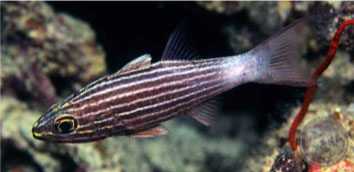Cardinalfish Information

Cardinalfish belong to the family Apogonidae. There are over 200 different species of cardinalfish, with at least 66 nominal genera and 32 valid genera. There are two major subfamilies. The majority of cardinalfish are part of the Apologoninae subfamily, while the remaining few belong to the Pseudaminae family. The fish may be freshwater, brackish or marine in nature, but they are generally nocturnal. The marine species prefer living in tropical and subtropical oceans of the Pacific, Indian and Atlantic Oceans. Some examples of residence include Thailand, the Solomon Islands, Papua New Guinea, Fiji and Australia. They can be found in shallow water coral or rocky reefs, as well as in seagrass and coralline algal meadows, softbottom communities, estuaries and lowland freshwater. They can be spotted along the shore to depths as deep as 300 meters. Some species in the Caribbean prefer taking up shelter in a living conch rather than crevices.
Cardinalfish may grow up to 5 to 20 centimeters in length depending on the species. They are a ray finned fish that possess two dorsal fins, a large mouth, large eyes and large scales. Their colors range from red to reddish, silvery, brownish or black. Their bodies are ovate to elongated and moderately compressed. The lower jaw is often protruding, and the jaws are lined with bands of small villiform teeth. Their scales are usually ctenoid, but some species have cycloid scales. Some, but not all, species of cardinalfish also have males that exhibit mouth brooding behavior. Like many small tropical fish, cardinalfish are sought out as aquarium fish. The Banggai Cardinalfish is actually listed as threatened under the Endangered Species act because it suffers from the effects of the ornamental live reef trade and habitat destruction. Agricultural runoff causes changes to the cardinalfish’s habit with the added fertilizer and phosphorus. Fish bombs used for capturing and harvesting live cardinalfish for aquariums introduce harmful cyanide to the reef.
